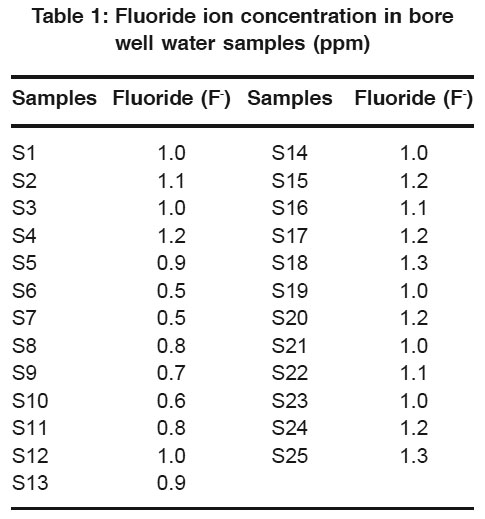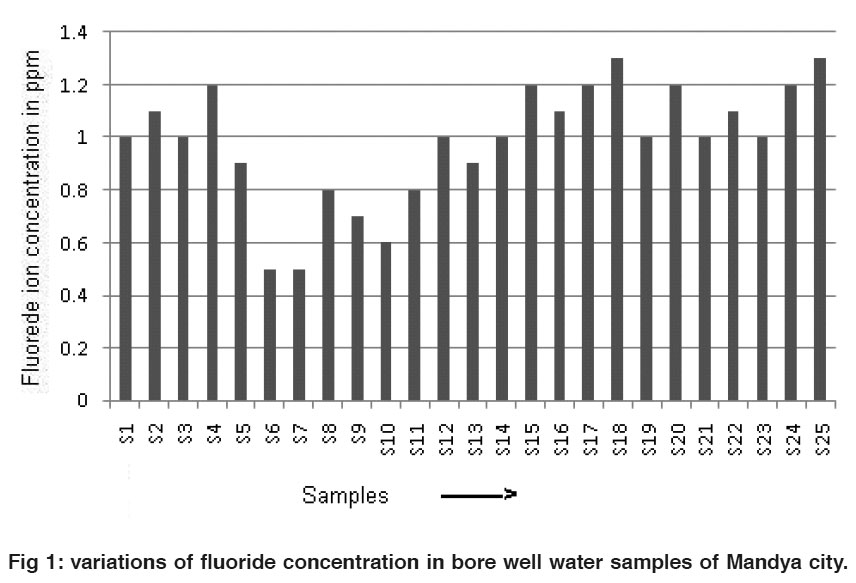Study of fluoride content in drinking water of selected bore-wells in Mandya city of Karnataka, India
C.S. Chidan Kumar1 * and S. Chandraju2
1
Department of Chemistry,
Bharathi College,
Mandya,
571 422
India
2
DOS in Sugar Technology,
Sir M.V.PG center,
Mandya,
571 402
India
DOI: http://dx.doi.org/10.12944/CWE.4.2.23
Major water supply for agriculture and domestic purpose in Mandya district is from Krishna Raja Sagar reservoir. Even then, residents of most of the areas of Mandya city are mainly dependent on bore well water for domestic and small scale industries, especially in summer season. Hence large numbers of bore wells are existed. Fluoride content of selected twenty five bore-well water in and around of Mandya city was analyzed in the month of January, 2009. The study reveals that the fluoride concentration is within the permissible limits in all places of Mandya city as prescribed by BIS and WHO. Hence the bore-wells water of Mandya city can be conveniently used for drinking without any pre-treatment.
Copy the following to cite this article:
Kumar C.S.C, Chandraju S. Study of fluoride content in drinking water of selected bore-wells in Mandya city of Karnataka, India. Curr World Environ 2009;4(2):409-411 DOI:http://dx.doi.org/10.12944/CWE.4.2.23
Copy the following to cite this URL:
Kumar C.S.C, Chandraju S. Study of fluoride content in drinking water of selected bore-wells in Mandya city of Karnataka, India. Curr World Environ 2009;4(2):409-411. Available from: http://www.cwejournal.org/?p=1000
Download article (pdf) Citation Manager Publish History
Select type of program for download
| Endnote EndNote format (Mac & Win) | |
| Reference Manager Ris format (Win only) | |
| Procite Ris format (Win only) | |
| Medlars Format | |
| RefWorks Format RefWorks format (Mac & Win) | |
| BibTex Format BibTex format (Mac & Win) |
Article Publishing History
| Received: | 2009-07-10 |
|---|---|
| Accepted: | 2009-08-21 |
Introduction
Mandya district is generally called as "sugar city" of Karnataka; since sugarcane is major crop of the district. The city has a very high heritage for its cultural and historical backgrounds. A famous Mysore sugar factory is located in the city. Krishna Raja Sagar (KRS) dam, historical temples at Melukote, Tippu palace at Sr iranga patna, Vaidyanatheshwara temple, Athmalingeshwara temple etc are situated in Mandya district.
Water is most common and impor tant resource on the earth (Suthar et al., 2001). However, the availability of water varies from place to place and time to time. As a result, there is a persistent scarcity of water in many par ts of the world. Exponential growth in population creates an ever- increasing demand of water for irrigation, industry and domestic use (Shankar et al., 2004; Wright, 2007).
Due to the population growth within the city than in the villages, the scarcity of water arises especially during summer season in Mandya city. Krishna Raja Sagar (KRS) dam mainly meets the demand of water for drinking and irrigation purpose, which is 28 km away from the city. But during summer season, there is shortage of water supply from KRS dam. As a result, a large number of bore wells existed in the city to meet the water demands. The poor quality of drinking water is more due to the contamination than due to the natural inferiority of the sources. Fluorides are present in both surface water and ground water. Most of the fluoride found in ground water results from weathering and circulation of water in rocks and soils. The chemical quality of ground water var ies even at short distances. This variation may be attributed to the variations in the hydro chemical process (Maniraju, 2006). Fluoride in small dosages has remarkable influence on the dental system inhibiting dental curies, while consumption of high dosage fluoride water causes fluorosis (Shukla et al., 2004). In India about 62 million people including 6 million children, suffer from fluorosis due to high content of Fluoride in water (Susheela, 1990). The present analysis is an attempt to evaluate the fluoride content of bore well water in Mandya city of Karnataka.
Material and Methods
In the present study, twenty five bore well water samples of selected areas in and around Mandya city were analyzed. The samples were collected in clean polythene bottles of 2 ltr capacity. The bottles were first rinsed with distilled water and then two to three times by the sample water before collecting for analysis.
 |
Table 1: Fluoride ion concentration in bore well water samples (ppm) Click here to view table |
Fluoride concentrations in water samples were determined using the parameters prescribed in standard methods for the Examination of water and wastewater APHA (1995). Water pollution levels at various spots in the city were analyzed and compared with that of drinking water standards prescribed by BIS and WHO.
 |
Figure 1: variations of fluoride concentration in bore well water samples of Mandya city. Click here to view figure |
Results and Discussion
Fluoride has little significance in industrial water; where as ingestion of excess fluoride in drinking water can cause fluorosis (Shukla et al., 2004), which affects the teeth and bones. Below the permissible limits, it is an effective preventive of dental cur ies, but above the permissible limits may cause disfigurement of teeth and severe skeletal fluorosis. Such water should be defluorinated to reduce fluoride concentration to the acceptable levels for drinking purpose.
The observed results were compared with the standard values of BIS and WHO (i.e., 0.6 -1.5ppm).
Conclusion
The present analysis concludes that, the fluoride concentration (Table: 1 and Fig: 1) of all the samples are well within the permissible limits as prescribed by BIS and WHO and the results reveals that the bore wells water of Mandya city are fit for drinking without any pretreatment for fluoride contents. But other physico-chemical parameters of these bore-wells water have to be analyzed for its suitability for drinking.
Acknowledgements
One of the authors C.S.Chidan Kumar is highly grateful for the Management of Bharathi Education Trust for permission to carry out this research work.
References
- APHA: AWWA and WEF, Standard methods of examination of water and waste waters (19th edition) Amer ican Public Health Association.Washington.D.C.(1995).
- BIS: Specification for drinking water IS: 10500: Bureau of Indian Standards, New Delhi (1991).
- Maniraju, Y.M.; Vijrappa, H.C, and Neelakantarama, J. M. Fluor ide concentration of water in Vrishabharathi river Basin, Bangalore District, Karnataka, Indian J. Environ. & Ecoplan.(2006) 12: 665-668.
- Shukla, J. B. and Kaur, H, Environmental Chemistry, Meerut, India. Susheela, A. K. 1999. Fluorosis management programme in India. Curr. Sci.(1994) 77: 1250-1256.
- Santra, S.C. Environmental Science, New Central Book Agency(P) Ltd. Pp.(2001) 195.
- Susheela, A.K.. Fluorosis management programme in India. Curr. Sci. (1999) 77: 1250-1256.
- WHO, Guidelines for drinking water quality (1984) Vol.1.







